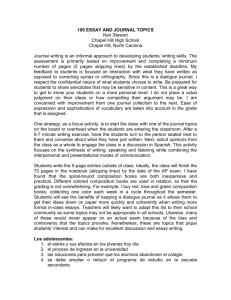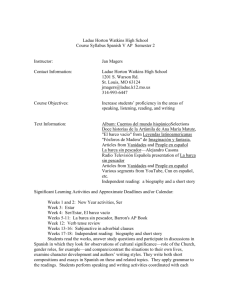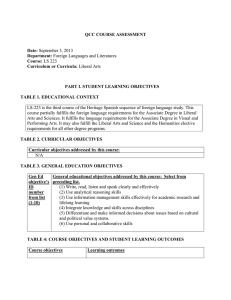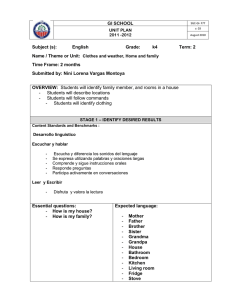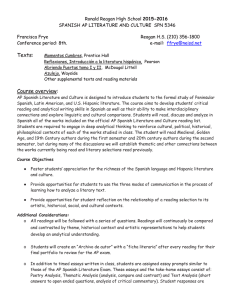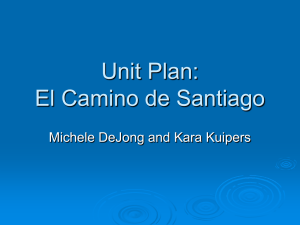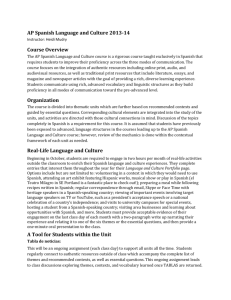QCC COURSE ASSESSMENT Date: Department:
advertisement
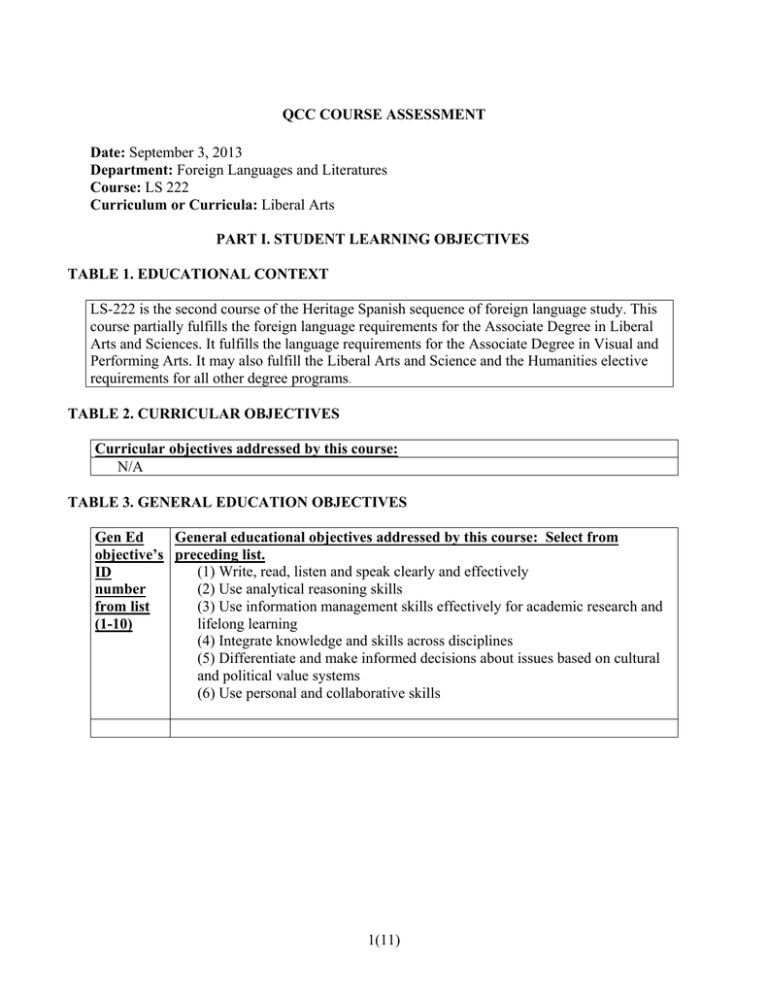
QCC COURSE ASSESSMENT Date: September 3, 2013 Department: Foreign Languages and Literatures Course: LS 222 Curriculum or Curricula: Liberal Arts PART I. STUDENT LEARNING OBJECTIVES TABLE 1. EDUCATIONAL CONTEXT LS-222 is the second course of the Heritage Spanish sequence of foreign language study. This course partially fulfills the foreign language requirements for the Associate Degree in Liberal Arts and Sciences. It fulfills the language requirements for the Associate Degree in Visual and Performing Arts. It may also fulfill the Liberal Arts and Science and the Humanities elective requirements for all other degree programs. TABLE 2. CURRICULAR OBJECTIVES Curricular objectives addressed by this course: N/A TABLE 3. GENERAL EDUCATION OBJECTIVES General educational objectives addressed by this course: Select from Gen Ed objective’s preceding list. (1) Write, read, listen and speak clearly and effectively ID (2) Use analytical reasoning skills number (3) Use information management skills effectively for academic research and from list lifelong learning (1-10) (4) Integrate knowledge and skills across disciplines (5) Differentiate and make informed decisions about issues based on cultural and political value systems (6) Use personal and collaborative skills 1(11) TABLE 4: COURSE OBJECTIVES AND STUDENT LEARNING OUTCOMES Course objectives Learning outcomes 1) Students will be able to read, analyze and interpret a variety of literary and non-literary Spanish texts dealing with key sociocultural aspects of Hispanics/Latinos in the United States 2) Students will be able to draw conclusions, express opinions, and define points of view in their oral and written discussions of literary and non-literary Spanish texts 3) Students will be able to write 2page reports in Spanish following the steps of the writing process (brainstorming, developing an outline for an essay, developing a draft, revising and self-editing) 4) Students will have an increased awareness of the vast range of Spanish varieties used throughout the Spanish-speaking world 5) Students will have an increased awareness of formal and informal oral and written registers 6) Students will have an increased confidence in their bilingual language strengths Student will be able to 1) name the characteristics of a good thesis; identify and write good theses 2) find bibliographical resources and include them in an essay using the appropriate format for references 3) describe the characteristics of a good summary; identify and write good summaries 4) describe strategies to create a good title 5) evaluate the title, introduction and conclusion of a text 6) explain the meaning of words related to immigration, identity, bilingualism and labor relations; use this vocabulary appropriately 7) use transitional words like “according to” and “however” appropriately 8) identify linguistic phenomena related to bilingualism such as code switching and cognates; provide alternative words and expressions for those linguistic phenomena 9) distinguish the verbal form “ha” from the preposition “a” 10) use the infinitive and the gerund in Spanish, and identify the differences with English 11) read, analyze and interpret a Spanish text dealing with key socio-cultural aspects of the Hispanic world 12) write 2 persuasive or argumentative essays on topics related to political and socio-cultural aspects of the Hispanic world. The essays should include a title, a clear thesis, opinions in favor and against the thesis, a conclusion and references 2(11) PART II. ASSIGNMENT DESIGN: ALIGNING OUTCOMES, ACTIVITIES, AND ASSESSMENT TOOLS TABLE 5: OBJECTIVES ADDRESSED IN ASSESSMENT ASSIGNMENT Course Objective(s) selected for assessment: (select from Table 4) 1) Students will be able to read, analyze and interpret a variety of literary and non-literary Spanish texts dealing with key socio-cultural aspects of Hispanics/Latinos in the United States 2) Students will be able to draw conclusions, express opinions, and define points of view in their written discussions of literary and non-literary Spanish texts 3) Students will have an increased awareness of formal and informal oral and written registers Curricular Objective(s) selected for assessment: (select from Table 2) N/A General Education Objective(s) addressed in this assessment: (select from Table 3) 1) Write, read, listen and speak clearly and effectively 2) Use analytical reasoning skills 3) Differentiate and make informed decisions about issues based on cultural and political value systems TABLE 6: ASSIGNMENT, OUTCOMES, ACTIVITIES, AND ASSESSMENT TOOLS The assessment tool is a comprehensive final exam that addresses the following course objectives and contents: 1. read, analyze and interpret an argumentative text dealing with socio-cultural aspects of Hispanics/Latinos in the United States 2. identify and apply the elements and steps of the writing process 3. write an argumentative essay 4. grammar and orthography activities 5. vocabulary activities (See appendix 1 for a copy of the final exam) Desired student learning outcomes for the assignment Students will be able to: Briefly describe the What assessment tools will be used to measure how well students range of activities student will engage in for have met each learning outcome? this assignment. 1) read, analyze and interpret a variety of literary and non-literary Spanish texts dealing with key socio-cultural aspects of Hispanics/Latinos in 1) Reading comprehension activities 3(11) 1) Students answer questions about a non-fiction text provided to them in the exam. the United States (Gen. Ed. Obj. 1 and 2) 2) draw conclusions, express opinions, and define points of view in their oral and written discussions of literary and non-literary Spanish texts (Gen. Ed. Obj. 1, 2 and 3) 2) Reading and writing skills activities, including writing a short argumentative essay 2) Students answer questions about a non-fiction text provided to them in the exam, and write an essay arguing in favor or against the minimum salary (one of the topics of the course). This writing assignment is evaluated using the rubric designed for this purpose. (See Appendix 2). Students answer questions related to the following topics: developing good theses, citing references, developing good summaries, describing the characteristics of good titles and conclusions. 3) have an increased awareness of formal and informal oral and written registers (Gen. Ed. Obj. 1) 3) Vocabulary activities. Grammar and orthography activities 3) Students answer vocabulary questions, provide transitional words within a paragraph, and distinguish between formal and informal expressions. Students answer questions related to the uses of “ha” vs. “a”, written accents, and the use of the infinitive vs. the gerund. PART III. ASSESSMENT STANDARDS (RUBRICS) TABLE 7: ASSESSMENT STANDARDS (RUBRICS) Brief description of assignment: The assessment tool is a comprehensive final exam that addresses the following course objectives and contents: 1. read, analyze and interpret an argumentative text dealing with socio-cultural aspects of Hispanics/Latinos in the United States 2. write an argumentative essay 3. knowledge of grammar and orthography 4. vocabulary knowledge (See Appendix 1 for a copy of the final exam) 4(11) Assessment measures for each learning outcome: Standards for student performance: 1) read, analyze and interpret a variety of literary and nonliterary Spanish texts dealing with key socio-cultural aspects of Hispanics/Latinos in the United States (Gen. Ed. Obj. 1 and 2) 1) Students answer questions about a non-fiction text provided to them in the exam. 1) Students’ reading comprehension ability will be determined by calculating their accuracy rates in their answers to reading comprehension questions. 75% of the students are expected to meet the course standard. 2) draw conclusions, express opinions, and define points of view in their oral and written discussions of literary and non-literary Spanish texts (Gen. Ed. Obj. 1, 2 and 3) 2) Students write an essay arguing in favor or against the minimum salary (one of the topics of the course). Students also answer questions related to the following topics: developing good theses, citing references, developing good summaries, describing the characteristics of good titles and conclusions. 2) The parameters used to measure students’ writing abilities in their essay will be determined by the written rubric (See Appendix 2). 75% of the students are expected to meet the course standard. 3) Students answer vocabulary questions, provide transitional words within a paragraph, and distinguish between formal and informal expressions. Students also answer questions related to the uses of “ha” vs. “a”, written accents, and the use of the infinitive vs. the gerund 3) Students’ vocabulary knowledge will be determined by calculating their accuracy rates in their answers to the vocabulary questions. 75% of the students are expected to meet the course standard. Students’ grammar and ortography knowledge will be determined by calculating their accuracy rates in providing the correct forms or structures. 75% of the students are expected to meet Desired student learning outcomes from the assignment. Students will: 3) have an increased awareness of formal and informal oral and written registers (Gen. Ed. Obj. 1) 5(11) the course standard. PART IV. ASSESSMENT RESULTS TABLE 8: SUMMARY OF ASSESSMENT RESULTS Desired student learning outcomes: Student achievement: Gen-Ed objectives 1) read, analyze and interpret a variety of literary and nonliterary Spanish texts dealing with key socio-cultural aspects of Hispanics/Latinos in the United States (Gen. Ed. Obj. 1 and 2) See Table 9. 2) draw conclusions, express opinions, and define points of view in their oral and written discussions of literary and nonliterary Spanish texts (Gen. Ed. Obj. 1, 2 and 3) 3) have an increased awareness of formal and informal oral and written registers (Gen. Ed. Obj. 1) TABLE 9. EVALUATION AND RESULTING ACTION PLAN 6(11) A. Analysis and interpretation of assessment results: 1. Written Final Examination The data below correspond to the performance of 44 students in the final exam, which was designed and used as the main assessment tool. The assessment included five categories: 1) writing skills, 2) vocabulary, 3) grammar and orthography, 4) reading comprehension, 5) essay writing. The results are as follows: Table 1 Average Score in Each Category Writing Vocabulary Grammar Reading Essay Total skills and Comprehension Writing Orthography Range 0-25 0-20 0-25 0-10 0-20 0-100 Average 17,18 12,37 18,19 8,01 13,92 69,68 Score # of 44 44 44 44 44 44 Students The total points a student could obtain (adding all five categories) was100. The Assessment Committee had defined the following performance scale: 0-60 points = student performance does not meet expectations; 61–73 points = student performance almost meets expectations; 74-89 points = student performance meets expectations; 90-100 = student performance exceeds expectations. The students’ average score in this assessment (69,68%) is within the range of 61-73 (“student performance almost meets expectations”). Table 2 Percentage of Students in Each Proficiency Level Range Does not meet Almost meets Meets expectations expectations expectations 0-60 61-73 74-89 0f 44 Students Percentage Exceeds expectations 90-100 10 19 12 3 23% 43% 27% 7% The overall student performance shows that 34% of students met or exceeded the expectations of this assessment process. 7(11) The results by percentage of students in each category are as follows: Table 3 Range Of 44 Students Percentage Writing skills. Student performance… Does not meet Almost Meets expectations meets expectations 0-14,75 expectations 18,50-22,25 15-18,25 Exceeds expectations 22,5-25 13 13 8 10 29,5% 29,5% 18% 23% Table 4 Range # Of 44 Students Percentage VOCABULARY. Student performance … Does not meet Almost meets Meets expectations expectations expectations 0-12 12,25-14,5 14,75-17,75 Exceeds expectations 18-20 25 8 10 1 57% 23% 18% 2% Table 5 Range # Of 44 Students Percentage GRAMMAR AND ORTOGRAPHY. Student performance … Does not meet Almost meets Meets Exceeds expectations expectations expectations expectations 0-14,75 15-18,25 18,50-22,25 22,5-25 11 8 17 8 25% 18% 39% 18% Table 6 Range READING. Student performance … Does not meet Almost meets Meets expectations expectations expectations 0-6 6,1-7,3 7,4-8,9 8 3 11 8(11) Exceeds expectations 9-10 22 # 0f 44 Students Percentage 18% 7% 25% 50% Table 7 Range ESSAY WRITING. Student performance … Does not meet Almost meets Meets expectations expectations expectations 0-12 12,25-14,5 14,75-17,75 Exceeds expectations 18-20 # 0f 44 Students Percentage 11 25% 14 32% 12 27% 7 16% B. Evaluation of the assessment process: The percentage of students who meet or exceed expectations in writing skills is 41%. The percentage of students who meet or exceed expectations in vocabulary is 20%. The percentage of students who meet or exceed expectations in grammar and orthography is 57%. The percentage of students who meet or exceed expectations in reading is 75%. The percentage of students who meet or exceed expectations in essay writing is 43%. When looking at the assessment results in relation to the Course Objectives and the General Education objectives, we observe the following: Course Objective 1: Students will read, analyze and interpret a variety of literary and non-literary Spanish texts dealing with key socio-cultural aspects of Hispanics/Latinos in the United States. The assessment tool measured students’ analytical reasoning in several ways: a) by asking students to evaluate a series of potential theses for an essay, b) by asking analytical questions about the reading provided (i.e. “Which would be the consequences of retro-acculturation on marketing and commercial activities?”), and b) by asking students to present written arguments in favor and against a socio-political issue (“minimum salary”) that had been part of the course readings and class discussions. Students’ performance in the specific analytical questions has yet to be calculated separately, but students overall performance in the sections with analytical questions shows that they are better prepared to apply analytical reasoning to reading comprehension questions (75% at or above level) than to develop original analytical reasoning in writing (essay part; 43%). Course Objective 2: Students will draw conclusions, express opinions, and define points of view in their oral and written discussions of literary and non-literary Spanish texts (Gen. Ed. Obj. 1, 2 and 3). Essay-writing results (43% at or above level) are consistent with the results in the answers to the writing-skills questions (41% at or above level). In both cases, less than half of the students assessed performed at the expected level. 9(11) Course Objective 3: Students will have an increased awareness of formal and informal oral and written registers (Gen. Ed. Obj. 1) The assessment tool measured students’ awareness of formal and informal oral and written registers by: a) asking grammar and spelling questions, and b) asking vocabulary questions. At 57%, the percentage of students who meet or exceed expectations in the grammar and orthography section of the assessment is below the expected 75% defined by the assessment committee. Students’ performance in the vocabulary activities is weak (20% of students at or above level). The lower percentage in the vocabulary task (20%), when compared to the reading task (75%), suggests that students’ understanding of vocabulary is stronger in the context of a reading than in isolated sentences. The assessment tool also measured students’ ability to make informed decisions (Gen. Ed. 3) by asking students to present written arguments in favor and against a socio-political issue that had been part of the course readings and class discussions (“minimum salary”), and by prompting them to defend one side of the issue. Students overall performance in the essaywriting section (41% at or above level) suggests that the majority of the students assessed did not master this objective’s skills. Nevertheless, students’ performance in the “Content” area of the essay (as defined in the rubrics), if calculated separately from the other writing categories, should produce more accurate information about the students’ level of acquisition of this skill (see Appendix 2 with rubrics). An in-depth examination of the assessment tool and results suggests the following: 1. The assessment tool was too long. Some students rushed through some parts of the exam, which might account for the differences in performance among the different sections of the assessment. 2. The level of difficulty among the different parts of the exam was uneven. This might also account for the differences in performance among sections. C. Resulting action plan: Only 34% of students completing the assessment tasks met or exceeded the expectations defined by the assessment committee, while 43% almost met the expectations (61-73 performance range). On average, students’ scores (69,68%) also fall within the range of 61-73 (“Student performance almost meets expectations”). The averages of each individual category show that all the areas are below expected levels, except for reading. Although the assessment committee will meet in the fall of 2013 for follow-up discussions of the assessment tool and the results, a preliminary review of the assessment process suggests the following: 1. The two sections of Spanish 222 that have been assessed have used a new textbook for the first time during the semester when the assessment was taking place. The assessment should be repeated after one or two semesters in order for instructors to gain enough knowledge of the new 10(11) textbook. 2. The assessment tool needs to be revised for a more homogeneous difficulty level among sections. 3. The assessment tool needs to be shortened. The next time that instructors conduct the assessment of this course, the assessment committee should consider the possibility of using the essay writing part of the exam as the entire assessment tool. In this case, the grading rubric should be revised and expanded, and the writing should take place on a different day than the final exam to allow students more time to complete it. 4. Ideally, the assessment committee should look at students’ performance in certain questions to obtain more specific information about students’ achievement of certain skills, such as analytical reasoning and the ability to make informed decisions based on socio-cultural value systems. To account for differences among instructors, the assessment committee also recommends that the results of the two classes assessed be compared. 5. Although it is possible that the use of an imperfect assessment tool has distorted the assessment results, the assessment committee should meet with the instructors of this course and discuss ways to improve the writing skills of Spanish heritage speakers. Some ideas include: provide more guided writing time and activities for heritage students, conduct analyses of good writing samples with heritage students, invite students to share writing pieces with their peers, edit and publish a volume with students’ writing, coordinate and train tutors at the Student Learning Center to help with Spanish heritage students’ writing, begin conversations with English composition instructors to: a) compare assessment tools and results, and b) share pedagogical strategies to improve students’ writing. APPENDICES APPENDIX 1: LS 222 - FINAL EXAM APPRENDIX 2: LS 222 - RUBRICS 11(11) LS 222 ASSESSMENT REPORT. APPENDIX 1 QUEENSBOROUGH COMMUNITY COLLEGE FOREIGN LANGUAGES DEPARTMENT LS222 – EXAMEN FINAL Spring 2013 Nombre ______________________________ NOTA _________/ 100 Parte 1: Destrezas de escritura (25 puntos) A. Tesis. Enumera las características de una buena tesis. Luego, lee cada una de las tesis que van a continuación e indica si tiene las características de una buena tesis. Explica por qué sí o no. a) Características de una buena tesis (3 puntos): 1. ___________________ 2. ____________________ 3. _____________________ b) ¿Son buenas tesis? (se dará 1 punto por evaluar la tesis correctamente como buena o mala y 1 punto por explicar la evaluación acertadamente; total = 10 puntos): 1) La inmigración es muy común en el mundo. ________________________________________________________________________________ ________________________________________________________________________________ ________________________________________________________________________________ 2) El spanglish es un horror. ________________________________________________________________________________ ________________________________________________________________________________ ________________________________________________________________________________ 3) El programa de inmersión dual es la mejor opción educativa para los estudiantes de Estados Unidos si este país no quiere quedarse detrás del resto de los países desarrollados. ________________________________________________________________________________ ________________________________________________________________________________ ________________________________________________________________________________ 4) Todo inmigrante debe asimilarse a la cultura del país. ________________________________________________________________________________ ________________________________________________________________________________ ________________________________________________________________________________ 5) Los rótulos ‘hispano/latino’ esconden las diferencias de clase social, lo cual hace que muchos hispanos o latinos que no necesitan ayuda la reciban. ________________________________________________________________________________ 1 ________________________________________________________________________________ ________________________________________________________________________________ B. Citas. Ordena los elementos de la siguiente referencia bibliográfica (1 punto). “El racista enmascarado”. Consultado el 2/12/2012. Carlos Fuentes. http://elpais.com/diario/2004/03/23/opinion/1079996405_850215.html __________________________________________________________________________________ __________________________________________________________________________________ __________________________________________________________________________________ C. Resúmenes. Según la tesis que hay a continuación, escoge el mejor resumen de los dos que se te presentan (1 punto): Tesis: El spanglish no es una forma incorrecta de hablar, sino una forma de comunicación apropiada para ciertos contextos y ciertas situaciones (“¿Traje de baño o traje con corbata?...”, 102). a) El español que se habla en Estados Unidos siempre va a tener influencia del inglés, incluso el de la primera generación de inmigrantes. Hay cuatro fenómenos importantes del spanglish: el cambio de código, los préstamos, los calcos y las extensiones. Muchos estudiantes latinos se sienten inseguros de su bilingüismo porque los han criticado por hablar spanglish, pero el spanglish es una forma correcta de hablar en ciertos contextos. b) Todas las lenguas cambian cuando entran en contacto. Este es un fenómenos inevitable de las lenguas y es absurdo querer que una lengua se conserve intacta, sin cambio ninguno, cuando está en relación constante con otra lengua que se habla en el mismo país. El spanglish es el resultado de este contacto constante entre el inglés y el español, y a pesar de lo que muchos creen, sigue unas reglas de uso, no es una mezcla arbitraria de las dos lenguas. El spanglish expresa una realidad: la de aquellos que viven en dos culturas al mismo tiempo. Por ello, no debe considerarse una manera incorrecta de hablar, sino una manera de hablar que es apropiada en determinados ambientes y circunstancias. Explica por qué has escogido esa opción (1 punto): __________________________________________________________________________ __________________________________________________________________________ __________________________________________________________________________ D. Títulos. ¿Qué estrategias usarías para crear un buen título? (1 punto). 1. Un juego de palabras 2. Repetición de sonidos 3. Una frase importante del texto 4. Todas las respuestas anteriores 5. Ninguna de estas respuestas E. Evalúa el título y la introducción de la lectura de este examen (“Los jóvenes hispanos y la retro-aculturación: Cambios en el marketing”). Nota: Contesta esta pregunta después de leer el texto. 2 Título: es bueno o no y por qué (1 punto). _________________________________________________________________________________ _________________________________________________________________________________ _________________________________________________________________________________ Introducción: es buena o no y por qué. ¿Qué estrategia se usa en esta introducción? (1 punto = evaluación de la introducción; 1 punto = identificación de la estrategia. Total = 2 puntos). _________________________________________________________________________________ _________________________________________________________________________________ _________________________________________________________________________________ _________________________________________________________________________________ _________________________________________________________________________________ F. Conclusiones. Responde las preguntas: 1. ¿Para qué sirve una buena conclusión? Señala todas las respuestas correctas (2 puntos). a) Para incluir una idea brillante, distinta a las que ya has analizado en la composición. b) Para repetir la tesis tal y como estaba en la introducción. c) Para conectar las ideas de tu composición. d) Para volver a mencionar brevemente los argumentos en contra de tu tesis y decir por qué tu argumento es mejor. 2. Describe una estrategia para crear una buena conclusión (1 punto). __________________________________________________________________________ 3. Describe un problema típico de las conclusiones (1 punto). __________________________________________________________________________ Parte 2. Vocabulario (20 puntos) A. Vocabulario de las lecturas. Explica el significado de las siguientes palabras dentro de las oraciones en las que están (10 puntos): 1. “...no puede dar trabajo a los indocumentados debido a tantos gobiernos de corrupción y despilfarro”. ________________________________________________________________________________ 2. “…su pasado, vinculado con el mundo hispano y el español, seguía siendo secreto”. ________________________________________________________________________________ 3. “Ese día, me alejé del niño desfavorecido que había sido días antes”. ________________________________________________________________________________ 4. “...ha ayudado a investigar y llevar a juicio cinco casos de esclavitud moderna”. ________________________________________________________________________________ 5. “En contra del mito que difunden las corporaciones estadounidenses...” ________________________________________________________________________________ 6. “…patrones egoístas y avaros que pagan sueldos de hambre a sus trabajadores”. 3 ________________________________________________________________________________ 7. “Pero equiparan la separación con la individualidad”. ________________________________________________________________________________ 8. “A una ingeniera civil se la indemnizó con $3 millones…” ________________________________________________________________________________ 9. “…también significa, querido contribuyente, que tus impuestos subvencionan las ganancias…” ________________________________________________________________________________ 10. “Las políticas de familia, tales como las bajas remuneradas por causas familiares…” ________________________________________________________________________________ B. Palabras de transición. Completa el siguiente párrafo con las palabras de transición que sean más adecuadas (4 puntos). de acuerdo con, es decir, sin embargo, aunque A pesar de doce años de paz relativa, un viernes de octubre de 2007 más de 1.000 agentes de la policía aparecieron en el Centro Histórico de la Ciudad de México para impedir que los vendedores ambulantes pusieran allí sus puestos. ___________________ el alcalde Ebrard, era necesario recuperar los espacios públicos y mejorar la calidad de vida en la ciudad, _________________, permitir que la gente pudiera caminar por las calles más fácilmente. Las noticias informaron de que se había conseguido echar a unos 15.000 vendedores ambulantes del centro de la ciudad. ________________, no estaba claro si la policía también iba a perseguir los comercios ambulantes de los barrios pobres que rodean el centro. _______________ la ciudad iba a concederles a los vendedores la posibilidad de vender durante la Navidad, esto era con la condición de que se fueran después del Año Nuevo y se trasladaran a zonas cercanas subsidiadas por el gobierno. Los vendedores argumentaron que esas zonas no atraerían a los clientes, pero como la mayoría de ellos no tienen representación sindical, probablemente los obligarán a irse del centro. C. Expresiones formales e informales. Escribe la oración en español formal (1 punto) y di si es calco, préstamo, cambio de código o extensión (2 puntos). Total = 6 puntos. 1. Cuando vi la hora, realicé que ya era muy tarde. ____________________________________________________________________________________ ____________________________________________________________________________________ 2. Por favor, llene usted estas formas para que le podamos dar asistencia médica a su hijo. ____________________________________________________________________________________ ____________________________________________________________________________________ 3. No me valían los pantalones que me compré, pero no me quisieron dar el dinero para atrás. ____________________________________________________________________________________ ____________________________________________________________________________________ Parte 3: Gramática y ortografía (25 puntos) A. Verbo “haber” y la preposición “a”. Escribe en el espacio en blanco “ha” o “a” (10 puntos). a. Ronald va ______ hablarle ______ la clase sobre su desacuerdo con las ideas de Gilchrist. b. Miguel empezó_________apreciar su propia cultura en la clase de español. c. Keila_______decidido que nunca va _______trabajar en un supermercado. 4 d. Diana camina _____la escuela porque _______comenzado un plan de ejercicios. e. Bryant se_______roto un pie. f. Va ______ haber muchas protestas en EEUU si no se sube el salario mínimo pronto. g. Estudiar en el parque y con buen tiempo me ayuda ______ recordar mejor todo. B. Acentuación. Encierra en un círculo la palabra apropiada (5 puntos). 1. Se/Sé me olvidó que tenía un examen a las doce. 2. No me acuerdo de si hablé/hable contigo sobre este tema. 3. Lorena no participo/participó en la carrera porque no le gusta competir. 4. No entiendo que/qué debo contestar aquí. 5. A veces me pregunto como/cómo puede sobrevivir una familia de cuatro con el salario mínimo. 6. Jorge Ramos publico/publicó el libro sobre inmigración en 2001. 7. No es justo que obliguen a hablar inglés/ingles en las escuelas. 8. Voy a hacer/ser todo lo posible por sacar una A en este examen. 9. Las mujeres llevan muchos anos/años esperando la igualdad laboral. 10. Los Minutemen dicen que va a ser/hacer los verdaderos guardianes de la frontera. C. Gerundios/Infinitivos.Traduce la siguiente oración al español, prestando atención a los verbos subrayados (5 puntos): 1. In Los Ángeles, speaking Spanish in public is very common. __________________________________________________________________________ 2. They are sick because of eating fast food. __________________________________________________________________________ 3. The were fired for organizing the workers. __________________________________________________________________________ 4. I believe that joining a union is the only way to get good working conditions. __________________________________________________________________________ 5. The only way to keep the Spanish language alive in the EEUU is teaching it to our children. __________________________________________________________________________ Parte 4. Comprensión y escritura (30 puntos) A. Comprensión. Lee el texto y responde las preguntas. Los jóvenes hispanos y la retro-aculturación: Cambios en el marketing Ozzie Godinez 5 Hoy en día, muchos jóvenes hispanos optan por mantener las tradiciones familiares y mezclarse con la cultura estadounidense dominante en lugar de asimilarse plenamente. En el pasado, los jóvenes hispanos por lo general se aculturaban en la cultura americana (lo que significaba cortar los lazos con sus tradiciones ancestrales), pero hoy hay una nueva tendencia. Los hispanos nacidos en EE.UU. están pasando por un cambio en la aculturación y están descubriendo el patrimonio cultural de sus familias. Muestran interés en la comida casera cocinada al estilo de la abuela, empiezan a escuchar música en español e incluso a perfeccionar su dominio del idioma. Este fenómeno se conoce como “retro-aculturación” y está produciendo cambios significativos en el mercado. Expliquemos bien los términos. La asimilación es la adaptación a la nueva cultura y la renuncia a la propia cultura de origen. Por otro lado, la aculturación significa adquirir ciertos rasgos de una nueva cultura mientras se mantienen algunos rasgos de la cultura de origen. Luego está la retro-aculturación. La retro-aculturación ocurre cuando una persona que ya se ha asimilado o que tiene un alto nivel de aculturación comienza a extrañar la cultura de origen, la de los padres o abuelos, y se esfuerza por recuperarla. Es un redescubrimiento de las raíces culturales de una persona. En el pasado, la retro-aculturación se producía entre los hispanos de segunda, tercera o cuarta generación que se asimilaban a la cultura estadounidense, pero querían volver atrás y aprender sobre su identidad cultural. Hoy en día, la retro-aculturación se está produciendo ya en niños de 11 años de edad y, a menudo, dentro de los hispanos de primera generación. A medida que pasan por su fase de auto-descubrimiento, ya sea en la adolescencia o en la adultez, los jóvenes hispanos comienzan a darse cuenta de la creciente influencia que, como grupo étnico, tienen en los EE.UU. Hay que tener en cuenta que en la escuela y en la universidad van a encontrarse con una gran diversidad. De repente, el ser parte de un grupo étnico es “cool”. El que era "George" empieza a presentarse como "Jorge". Este despertar a su cultura impulsa a los jóvenes hispanos a buscar actividades que les darán un sentido de conexión con sus tradiciones. De los más de 50 millones de hispanos en los EE.UU., el 62% tiene entre 14 y 34 años de edad. De ellos, más de un tercio se identifica como hispano y estadounidense. A medida que los mayores del grupo empiezan a tener sus propios hijos, las empresas no podrán permitirse el lujo de pasar por alto la retro-aculturación. Los jóvenes hispanos buscan experiencias latinas auténticas, ya sea a la hora de adquirir más fluidez en español, de grabar música latina en sus iPods o de cocinar platos tradicionales con la familia. ¿Qué significa esto para el marketing y las ventas? Los hispanos se harán más conscientes de las experiencias culturales auténticas que les ofrecen las marcas dirigidas a ellos. Las marcas que ya son conocidas en sus países de origen podrían comenzar a vender más en los EE.UU., mientras que las principales marcas estadounidenses que tienen versión latina o una línea de productos latinos podrían empezar a considerarse poco auténticas. En lugar de comprar salsas de las estanterías de los supermercados, los jóvenes latinos podrían empezar a buscar salsas recién hechas en una tienda pequeña del vecindario o en un supermercado hispano. Quizás prefieran hacer ellos mismos la salsa en casa. Estas preferencias pueden suponer una grave amenaza para muchas marcas. Aunque algunas marcas tienen como objetivo vender productos latinos al mercado general y no necesariamente a los hispanos, el crecimiento de la población estadounidense está impulsado por los latinos, que llegarán a convertirse en el mercado general y producirán un gran cambio en las ventas al buscar productos que les ayuden a celebrar y a redescubrir su herencia. Preguntas: Nota: No se darán puntos a las respuestas que estén copiadas literalmente del texto. Debes expresar las respuestas con tus propias palabras, demostrando comprensión de lo leído. 1. Explica las diferencias entre la “asimilación” y la “aculturación” (1 punto = la respuesta demuestra comprensión, pero falta desarrollo; 2 puntos = la respuesta demuestra comprensión y está suficientemente desarrollada). ________________________________________________________________________________________ ________________________________________________________________________________________ ________________________________________________________________________________________ ________________________________________________________________________________________ ________________________________________________________________________________________ 2. Según este texto, ¿qué es la “retro-aculturación”? (1 punto = la respuesta demuestra comprensión, pero falta desarrollo; 2 puntos = la respuesta demuestra comprensión y está suficientemente desarrollada). 6 ________________________________________________________________________________________ ________________________________________________________________________________________ ________________________________________________________________________________________ ________________________________________________________________________________________ ________________________________________________________________________________________ 3. ¿Qué consecuencias tendrá la “retro-aculturación” en el mercado de consumo de EEUU? (1 punto = la respuesta demuestra comprensión, pero falta desarrollo; 2 puntos = la respuesta demuestra comprensión y está suficientemente desarrollada). ________________________________________________________________________________________ ________________________________________________________________________________________ ________________________________________________________________________________________ ________________________________________________________________________________________ ________________________________________________________________________________________ 4. ¿Conoces fenómenos de “retro-aculturación”? Descríbelos (1 punto = la respuesta demuestra comprensión, pero falta desarrollo; 2 puntos = la respuesta demuestra comprensión y está suficientemente desarrollada). ________________________________________________________________________________________ ________________________________________________________________________________________ ________________________________________________________________________________________ ________________________________________________________________________________________ ________________________________________________________________________________________ 5. Relaciona este texto con algunas de las lecturas que hemos hecho durante el curso (1 puntos = la respuesta relaciona el texto con una de las lecturas del curso y explica las conexiones; 2 puntos = la respuesta relaciona el texto con dos o más lecturas del curso y explica las conexiones). ________________________________________________________________________________________ ________________________________________________________________________________________ ________________________________________________________________________________________ ________________________________________________________________________________________ ________________________________________________________________________________________ ________________________________________________________________________________________ ________________________________________________________________________________________ B. Escritura. Piensa en las lecturas del capítulo 4. Escribe una carta al Secretario de Trabajo (Labor Secretary), Seth Harris, en la que defiendes una tesis relacionada con el salario mínimo (por ejemplo, que se debe mantener, bajar, eliminar, aumentar, etc.). Además de la tesis, la carta debe incluir algunos de los argumentos que hay en contra de tu tesis y una conclusión (20 puntos). ________________________________________________________________________________________ ________________________________________________________________________________________ ________________________________________________________________________________________ ________________________________________________________________________________________ ________________________________________________________________________________________ ________________________________________________________________________________________ ________________________________________________________________________________________ ________________________________________________________________________________________ ________________________________________________________________________________________ ________________________________________________________________________________________ ________________________________________________________________________________________ ________________________________________________________________________________________ ________________________________________________________________________________________ ________________________________________________________________________________________ ________________________________________________________________________________________ ________________________________________________________________________________________ ________________________________________________________________________________________ ________________________________________________________________________________________ 7 ________________________________________________________________________________________ ________________________________________________________________________________________ ________________________________________________________________________________________ ________________________________________________________________________________________ ________________________________________________________________________________________ ________________________________________________________________________________________ ________________________________________________________________________________________ ________________________________________________________________________________________ ________________________________________________________________________________________ ________________________________________________________________________________________ ________________________________________________________________________________________ ________________________________________________________________________________________ ________________________________________________________________________________________ ________________________________________________________________________________________ ________________________________________________________________________________________ ________________________________________________________________________________________ ________________________________________________________________________________________ ________________________________________________________________________________________ ________________________________________________________________________________________ ________________________________________________________________________________________ ________________________________________________________________________________________ ________________________________________________________________________________________ ________________________________________________________________________________________ ________________________________________________________________________________________ ________________________________________________________________________________________ ________________________________________________________________________________________ ________________________________________________________________________________________ ________________________________________________________________________________________ ________________________________________________________________________________________ ________________________________________________________________________________________ ________________________________________________________________________________________ ________________________________________________________________________________________ ________________________________________________________________________________________ ________________________________________________________________________________________ ________________________________________________________________________________________ ________________________________________________________________________________________ ________________________________________________________________________________________ ________________________________________________________________________________________ ________________________________________________________________________________________ ________________________________________________________________________________________ ________________________________________________________________________________________ ________________________________________________________________________________________ ________________________________________________________________________________________ ________________________________________________________________________________________ ________________________________________________________________________________________ ________________________________________________________________________________________ ________________________________________________________________________________________ ________________________________________________________________________________________ ________________________________________________________________________________________ ________________________________________________________________________________________ ________________________________________________________________________________________ ________________________________________________________________________________________ ________________________________________________________________________________________ ________________________________________________________________________________________ ________________________________________________________________________________________ ________________________________________________________________________________________ ________________________________________________________________________________________ ________________________________________________________________________________________ ________________________________________________________________________________________ 8 9 LS 222 ASSESSMENT REPORT. APPENDIX 2 RUBRIC Task Completion Performance exceeds expectations Superior completion of the task. Student fully addresses the information requested, and provides additional details 4 POINTS Completion of task. Student fully addresses the information provided, but does not provide additional details 3 POINTS Partial completion of task. Student completes no more than 60% of the information requested 2 POINTS Minimal completion of task. Student completes less than 40% of the information requested and/or writes the essay in English 1 POINT Performance meets expectations Performance almost meets expectations Performance does not meet expectations Level of Discourse Sentences are fully developed and interconnected with cohesive devices 4 POINTS Sentences are fully developed. Cohesive devices are sporadically used 3 POINTS Sentences are somewhat complete. Rare use of cohesive devices 2 POINTS Vocab. Spelling Grammar Rich use of vocabulary 4 POINTS Accuracy level 90% ‐ 100% 4 POINTS Adequate and accurate use of vocabulary 3 POINTS Somewhat inadequate and/or inaccurate use of vocabulary 2 POINTS Accuracy level 79% ‐ 89% 3 POINTS Accuracy level 61% ‐ 78% 2 POINTS Perfect or near perfect control of the syntactic structures required. Minimal English interference or none at all (Accuracy level 90% ‐ 100%) 4 POINTS Adequate control of the syntactic structures. Some grammatical errors. Some English interference and occasional anglicisms (Accuracy level 79% ‐ 89%) 3 POINTS Insufficient control of the syntactic structures. Several grammatical errors. English interferes often and student often recurs to anglicisms (Accuracy level 61% ‐ 78%) 2 POINTS Sentences are mostly incomplete. No use of cohesive devices 1 POINT Inadequate and/or inaccurate use of vocabulary 1 POINT Accuracy level 0%‐ 60% 1 POINT Minimal control of the syntactic structures. Numerous grammatical errors. Student resorts to English most of the time. (Accuracy level 0%‐ 60%) 1 POINT
